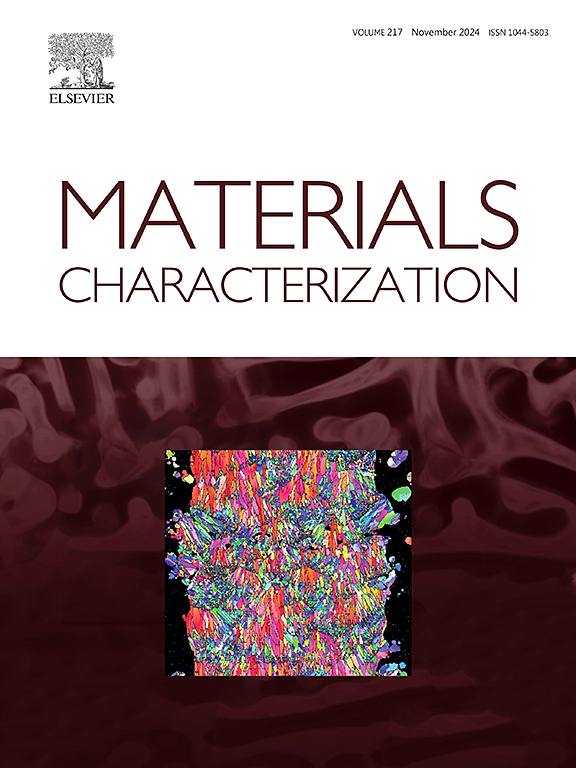氧化物+ TiN使等轴δ-铁素体晶粒形核,提高铁素体不锈钢焊缝的拉伸性能
IF 4.8
2区 材料科学
Q1 MATERIALS SCIENCE, CHARACTERIZATION & TESTING
引用次数: 0
摘要
研究了铁素体不锈钢焊缝中氧化物+TiN的拉伸性能以及氧化物与TiN的取向关系。结果表明,经氧化锡+锡核的等轴试样的极限拉伸强度和伸长率分别提高了15%和50%。Ti2O3、Al2O3、Al2Ti7O15和MgAl2O4等氧化物加速了TiN的形成,说明了δ-铁素体的成核。Ti2O3和Al2O3表现为{0001}氧化物// {111}TiN和[1010]氧化物// [110]TiN取向,与TiN的失配率分别为0.6%和8.1%。MgAl2O4在所有晶体取向上都与TiN完全平行,与TiN的失配率为4.8%。由于{204}Al2Ti7O15 // {002}TiN、[20−1]Al2Ti7O15 //[1−10]TiN和[020]Al2Ti7O15 // [220]TiN的取向关系有3.6%的错配,Al2Ti7O15是新发现的TiN的成核位点。等轴晶的形成促进了拉伸断口的脆性向韧性转变,极大地打乱了滑移系统,导致较大的晶内变形。本文章由计算机程序翻译,如有差异,请以英文原文为准。
Nucleation of equiaxed δ-ferrite grain by Oxide + TiN to improve tensile properties of ferritic stainless steel welds
This study investigated the tensile properties of ferritic stainless steel welds with Oxide+TiN and the crystal orientation relationship between oxides and TiN. It revealed that the ultimate tensile strength and elongation were improved by 15 % and 50 % in the equiaxed specimen nucleated by Oxide+TiN, respectively. The formation of TiN was accelerated on the oxides Ti2O3, Al2O3, Al2Ti7O15, and MgAl2O4 for elucidating the δ-ferrite nucleation. Ti2O3 and Al2O3 exhibited {0001}oxide // {111}TiN and [1010]oxide // [110]TiN orientations, resulting in misfits of 0.6 % and 8.1 % with TiN, respectively. MgAl2O4 was fully parallel to TiN in all crystal orientations and exhibited a misfit of 4.8 % with TiN. Al2Ti7O15 was newly discovered as a nucleation site for TiN, attributed to a 3.6 % misfit in the orientation relationships of {204}Al2Ti7O15 // {002}TiN, [20−1]Al2Ti7O15 // [1−10]TiN, and [020]Al2Ti7O15 // [220]TiN. The brittle to ductile transition of the tensile fracture was promoted by formation of equiaxed grain, which greatly random the slip system for larger intragranular deformation.
求助全文
通过发布文献求助,成功后即可免费获取论文全文。
去求助
来源期刊

Materials Characterization
工程技术-材料科学:表征与测试
CiteScore
7.60
自引率
8.50%
发文量
746
审稿时长
36 days
期刊介绍:
Materials Characterization features original articles and state-of-the-art reviews on theoretical and practical aspects of the structure and behaviour of materials.
The Journal focuses on all characterization techniques, including all forms of microscopy (light, electron, acoustic, etc.,) and analysis (especially microanalysis and surface analytical techniques). Developments in both this wide range of techniques and their application to the quantification of the microstructure of materials are essential facets of the Journal.
The Journal provides the Materials Scientist/Engineer with up-to-date information on many types of materials with an underlying theme of explaining the behavior of materials using novel approaches. Materials covered by the journal include:
Metals & Alloys
Ceramics
Nanomaterials
Biomedical materials
Optical materials
Composites
Natural Materials.
 求助内容:
求助内容: 应助结果提醒方式:
应助结果提醒方式:


